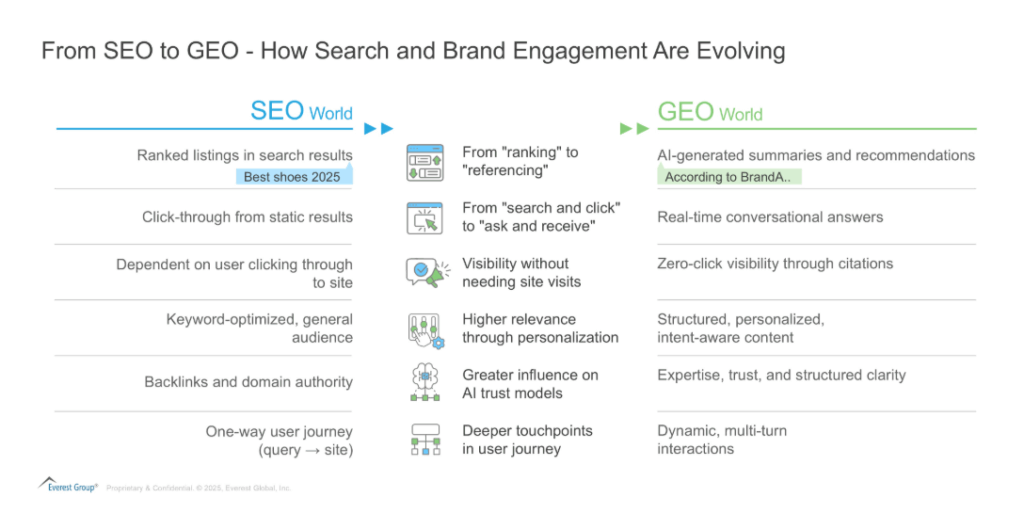Is Your Brand Ready to Be Quoted by AI? Welcome to GEO

Imagine asking a complex question and getting the perfect answer instantly, and without clicking a single link. That’s not a glimpse into the future; it’s happening now. For decades, traditional Search Engine Optimization (SEO) was about ranking high in Google’s blue links through keyword stuffing and backlink building. But today, a new paradigm is taking hold: Generative Engine Optimization (GEO).
GEO is about optimizing content not just to rank but to be used by artificial intelligence (AI)-powered platforms like ChatGPT, Google’s Search Generative Experience (SGE), and Perplexity.
It’s no longer about being clicked, it’s about being quoted. We’re entering a world where success means being embedded in AI-generated responses, not just appearing on a results page. The old keyword playbook is giving way to a new era of AI-driven, conversational search.
Reach out to discuss this topic in depth.
Goodbye SEO, hello GEO?
Traditional SEO strategies were built around keywords, backlinks, and metadata, all aimed at getting your website to rank highly on search results pages. But with Generative AI (gen AI) tools, like ChatGPT, Google’s Search Generative Experience (SGE), and Perplexity AI users are increasingly getting answers without ever clicking on a website link.
In the GEO era, optimizing isn’t about simply appearing in search results; it’s about ensuring AI tools reference your content directly. Brands are no longer fighting for clicks, they’re fighting to be cited, recommended, and trusted by AI.
Exhibit 1 is a visual framework of the evolution from SEO to GEO.

Central tenets of Generative Engine Optimization (GEO)
Generative Engine Optimization (GEO) fundamentally reshapes how brands approach visibility and engagement in the era of AI-driven search and discovery. Unlike traditional SEO, which revolves around keywords and clicks, GEO focuses on positioning brands directly within AI-generated conversations.
Its central tenets include conversational optimization, structured content, authority and trust , zero-click visibility, personalization readiness, and proactive AI monitoring, equipping brands to thrive in a digital landscape increasingly mediated by gen AI, conversational interfaces, and personalized experiences.
Exhibit 2 outlines the six tenets of GEO.

What GEO means for brand visibility and commerce
In the GEO world, the top result isn’t always a link, it’s a quote. If the AI says, “According to YourCompany…,” you’ve already won. But if your brand isn’t trusted or structured for AI discovery, it may be left entirely.
AI models evaluate content based on quality, clarity, and credibility, often following principles like Google’s E-E-A-T (Experience, Expertise, Authoritativeness, Trustworthiness). If your brand doesn’t meet those standards, AI may cite a competitor instead.
This shift is reshaping commerce too. Instead of browsing multiple sites, users now ask AI, “What’s the best laptop under $800?” and receive just one or two recommendations. If your product isn’t among them, you’re invisible in that journey. That’s why getting cited consistently and credibly is the new front line of brand visibility.
From clicks to prompts: Reengineering the MarTech Stack for GEO
Generative Engine Optimization (GEO) is fundamentally reshaping digital discovery by compressing the traditional marketing funnel. In a GEO-first world, users may not even reach a brand’s website interactions and decisions increasingly occur within AI-generated summaries, assistants, or answer engines.
As a result, MarTech stacks must evolve to influence the conversation before it reaches the touchpoints owned. This includes deploying structured, trustworthy, and machine-readable content that can be surfaced by generative systems, alongside capabilities to track indirect engagement and measure brand presence in upstream AI interactions.
The reduced visibility into the user journey increases the urgency for robust first-party data strategies, next-generation attribution tools that account for dark funnel dynamics, and a more agile, automated content supply chain.
In essence, GEO demands a stack that is not only reactive but anticipatory shaping how and where brand narratives are picked up by AI intermediaries and maintaining relevance in channels marketers no longer fully control.
Adapting to the GEO era: new strategies for marketers
The shift from traditional SEO to Generative Engine Optimization doesn’t mean everything we know is obsolete, but it does mean our tactics must evolve. Marketing leaders and SEO professionals can take concrete steps to adapt and thrive in this new GEO landscape. Here are some key strategies:
-
- Structure content for AI readability
Use clear formatting, headings, bullet points, concise paragraphs, and implement schema markup, so AI can easily identify and extract your content. Think of it as giving the algorithm a clean map of your knowledge
-
- Optimize for conversational queries
Write content that answers real, natural-language questions. Use Question and Answer (Q&A) formats and summaries that sound like a helpful assistant. Structure content like a dialogue to make it AI-friendly and response-ready
-
- Build authority and trust signals
Strengthen your E-E-A-T (Experience, Expertise, Authoritativeness, Trustworthiness). Feature expert bylines, cite credible sources, and showcase reviews or case studies. The more trustworthy your content, the more likely AI is to surface it
-
- Monitor and adapt to AI outputs
Regularly test how AI platforms respond to industry questions. If your brand isn’t mentioned, refine your content. Treat AI interfaces like new Search Engine Results Pages (SERPs) optimize not just for visibility, but for being quoted
-
- Evolve your tech stack for GEO
Your tech stack should support structured, AI-friendly content and track indirect engagement. Prioritize Content Management System (CMS) platforms with schema and modular content capabilities, Customer Data Platforms (CDPs) for first-party data activation, and attribution tools suited for AI-influenced journeys. Strengthen your content supply chain to ensure fast, consistent, and trustworthy delivery across generative platforms
Embracing the generative future of search
GEO signals a powerful shift from chasing algorithms to genuinely serving users. In this new landscape, quality and clarity matter more than ever. The goal hasn’t changed to help people find what they need, but the methods have.
For marketing leaders, this is a moment of reinvention. Those who embrace the shift, retool their strategies, and meet AI on its terms won’t just stay visible; they’ll become the voices AI chooses to amplify.
The future of search is being written by AI. The question is: will your brand be part of the answer?
If you enjoyed this blog, check out our Artificial Intelligence Technology Solutions – Everest Group, which delves deeper into other topics regarding artificial intelligence.
To learn more about GEOs, as well as anything else relating to artificial intelligence, please contact Lochan Surana ([email protected]).